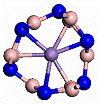Department of Physics and Astronomy: Publications and Other Research

Stephen Ducharme Publications
Document Type
Article
Date of this Version
May 1999
Abstract
The grating formation speed in photorefractive polymers is greatly reduced by highly polar molecules incorporated by necessity in large concentrations to produce large diffraction efficiency and two-beam energy coupling gain. The random electric fields generated by these dipoles interfere with charge transport by increasing the width of the hopping site energy distribution and thus greatly reducing the carrier mobility and the photorefractive speed. We conducted transport studies of several model systems consisting of combinations of two polymer binders, six charge transport agents (four for holes and two for electrons), and varying concentrations of two highly polar electro-optic chromophores. The results confirm that carrier mobility is greatly reduced in the presence of polar molecules in accordance with the predictions of models of hopping transport in the presence of dipolar disorder. The randomly positioned and oriented dipoles increase the width of the hopping site energy distribution by an amount proportional to the square root of the dipole concentration and to the strength of the dipole moment. The results also show that transport agents with smaller dipole moments reduce the sensitivity to the dipolar effect. The photorefractive speed may therefore be increased by using transport agents with small dipole moments.


Comments
Published by American Institute of Physics. J. Applied Physics 85, 6506-14 (1999). ©1999 American Institute of Physics. Permission to use. Journal home page = http://jap.aip.org/jap/.